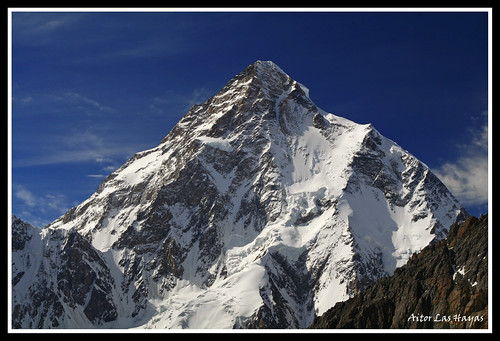 "There are only three sports: bullfighting, motor racing and mountaineering; all the rest are merely games." Ernest Hemingway
"There are only three sports: bullfighting, motor racing and mountaineering; all the rest are merely games." Ernest HemingwayIt is easy to forget standing on top of a mountain that the job is only half done. Legendary climber Ed Viesturs famously said, "getting to the top is optional, getting back to the bottom is mandatory". Mountaineers prepare for months and wait years just to take a crack at their target. All for what? A few minutes of taking in the scenery, waving a flag, snapping a photo and hopefully living to tell the tale. On August 1 of this year a record eighteen people managed to reach the summit of K2. Within 24 hours though, 11 of the climbers were dead- not around to tell the tale! (CBS Video).
The physical aspect of these climbs is daunting enough, but that is not the half of it. At these severe altitudes there is only a third the amount of oxygen available compared to sea-level and consequently the brain functions a lot slower. It debilitates your thinking and slows your reactions to the point of making you clumsy. Reaching the summit has its own exhaustion, so descents are even more dangerous and often more deadly. No surprise then that it was on a miscalculated descent, that most of the lives were lost!
If you ask a child to draw a tall mountain, they are most likely to come up with the form o
There is reason to believe however, that much like the 1996 Everest disaster, made famous in the excellent Jon Krakauer book "Into Thin Air", the recent disaster on K2 involved human error. The various routes up the K2 all converge in an aptly named alley called "the bottleneck". This is where on the night of August 1 at least five different teams merged on their way to the peak. Bad weather had held them from making a push towards the peak for several weeks and the first break saw different teams summit bound at the same time. This resulted in a high altitude traffic jam.
Other factors contributed. Shaheen Baig, the most experienced K2 Sherpa was sent back down the mountain after suffering from altitude sickness. The other Sherpas sent ahead to attach fixed lines on the treacherous part of the climb at the end of the "bottle neck", laid them down too early and ran out of rope on the technically difficult top part. Then, making his way up the ropes, Serbian climber Dren Mandic lost his grip and plunged to his death. A Pakistani porter by the name of Jehan Baig lost his life trying to recover the Serb's body. The resulting delay pushed the summit push into late afternoon, assuring a treacherous descent in the dark. The expeditions should have turned back at this point. Lacking the benefit of hindsight, as well as 66 percent of oxygen feeding their brains, the climbers chose to go on. It would prove to be a fatal mistake.
To compound matters, a serac tore loose on their way back sweeping four more climbers to their deaths and tearing the fixed lines to be used by others in their descent. This trapped 17 climbers above 26,000 ft in the "death zone", known as such because it gets exponentially difficult to survive up there beyond 24 hours. During the nocturnal descent Frenchman Hugues d'Auberede and his Pakistani porter Meherban Kerim lost their footing and both were never found again. A team of three Korean climbers got tangled up in ropes and climber after climber passed them by unable to help. The Irish climber Gerard McDonnell went back to help them and all four died in a slide of ice and snow.
The post-mortem started immediately. Survivor Wilco Van Rooijen speaking from his bed in Combined Military Hospital Rawalpindi told of many different expeditions trying to summit at the same time and having difficulty coordinating with each other. He blamed the commercial aspect of climbing where adventure tourists without adequate climbing skills were showing up to take trophies back home. As a team you are as slow as your worst climber, so it took them twelve hours through the seracs whereas normally it should have taken them four or five.
Unlike the doomed Everest expedition, where the real story only emerged a year and a half later, this one was bizarrely followed in real time by thousands on the blog of American climber Nicholas Rice, who had wisely decided to retreat from the bottle-neck. Modern technology might have changed aspects of how we communicate and spectate, but as far as mountaineering is concerned, it always comes down to man versus mountain- and we know only one of them ever blinks...
3 comments:
Faisal, that one is superbe ( K2 ), wonder where you got that insightfull touch from as your experience with mountains i was aware of was more of broken collarbones and stupid bets - guess it comes from the fact it happened in ur home country.... Cheerio
Xavier
Great story,I had missed this one completely in the newsrounds. Stories like these are what I keep coming back to your site for ......nice one.
Sunir
The 3 sports quote is generally thought a misattribution given to Hemingway.
Post a Comment